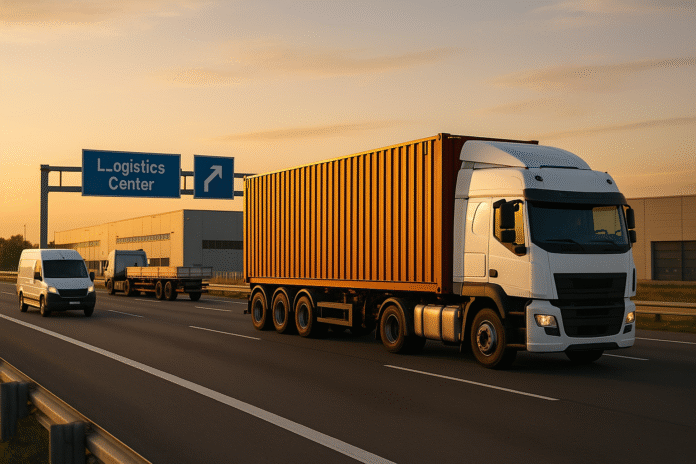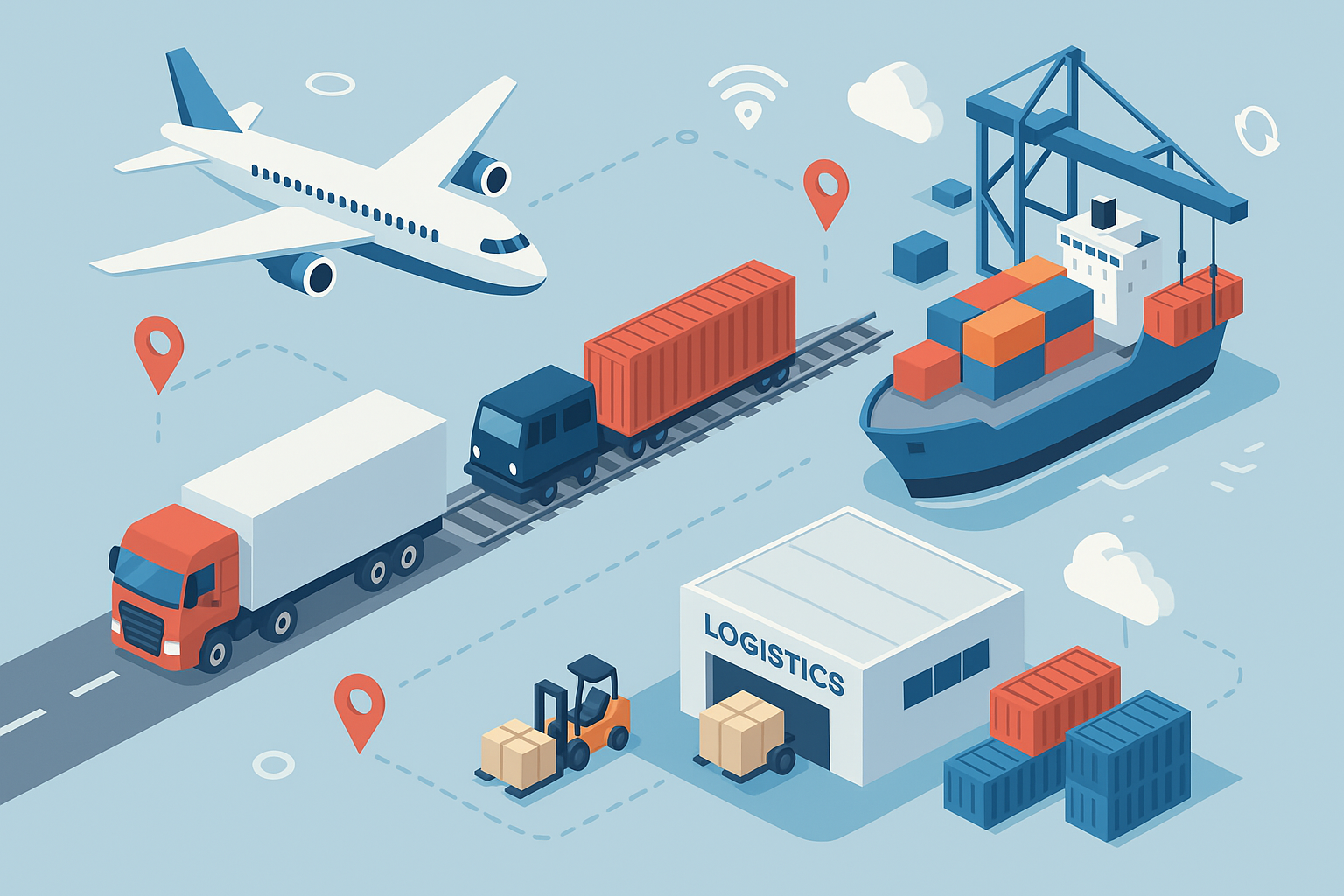In the intricate world of supply chain and logistics, road transport plays a vital role in ensuring goods are delivered safely and on time. From first-mile to last-mile delivery, road freight is the backbone of domestic transportation and an essential link in international trade. But how exactly does road transport work in freight logistics?
This blog provides a comprehensive breakdown of the processes, components, advantages, and challenges of road transport in freight logistics — helping beginners and industry professionals alike understand its strategic importance.
What is Road Transport in Freight Logistics?
Road transport refers to the movement of goods using motor vehicles such as trucks, vans, and trailers via highways, roads, and streets. Unlike air, rail, or sea, road transport offers unmatched flexibility and is crucial for short to medium distances. It often functions as the first and last leg of intermodal freight transport, linking warehouses, ports, airports, and final destinations.
Example: A manufacturer in Pune needs to send machinery parts to a warehouse in Bangalore. Using a heavy-duty truck, the shipment is delivered directly to the facility in 2 days — making road transport the most flexible and time-efficient option.
Key Components of Road Freight Transport
To understand how road freight works, let’s explore the essential components involved:
a. Vehicles
- Light Commercial Vehicles (LCVs): Used for small loads and last-mile delivery (e.g., vans).
- Heavy Goods Vehicles (HGVs): Include rigid trucks and articulated lorries for long-distance and bulk transportation.
- Specialized Trucks: Refrigerated, flatbed, tankers, and container carriers.
b. Infrastructure
- Road Networks: National highways, expressways, city roads, and rural access roads.
- Logistics Hubs: Warehouses, cross-docking stations, distribution centers.
- Checkpoints: Toll booths, weighbridges, customs checkposts for cross-border road freight.
c. Drivers & Operators
Drivers are licensed professionals trained to handle specific types of vehicles and cargo, often supported by logistics coordinators and dispatch systems.
d. Technology
- GPS & Telematics: Real-time tracking and route optimization.
- Transportation Management Systems (TMS): Help plan, execute, and analyze road freight operations.
- Electronic Logging Devices (ELDs): Monitor driver hours and vehicle performance.
Types of Road Freight Services
Road transport in logistics can be categorized based on service models:
a. Full Truckload (FTL)
- The entire vehicle is reserved for one shipment.
- Ideal for high-volume, heavy goods, or when fast delivery is essential.
- Offers better security and shorter transit times.
Example: A beverage company shipping 20 pallets of soft drinks from a bottling plant in Delhi to a distributor in Jaipur would use an FTL truck for exclusive use and quicker delivery.
b. Less than Truckload (LTL)
- Multiple shipments from different shippers share the same vehicle.
- Cost-effective for small or medium shipments.
- Involves more handling and transit points.
Example: A small business sends a few cartons of garments from Mumbai to Surat. It uses LTL shipping where space is shared with other shipments, making it more affordable.
c. Express & Courier Services
- Time-sensitive and lightweight cargo.
- Suitable for eCommerce and urgent deliveries.
d. Specialized Freight
- Transport of hazardous materials, temperature-controlled goods, or oversized cargo with regulatory compliance.
Example: A pharmaceutical firm transporting vaccines at -20°C uses a refrigerated truck (reefer) to maintain the required cold chain during road transit.
Road Transport Process in Freight Logistics
Let’s explore a typical road freight journey from origin to destination:
Step 1: Order Booking
Shippers book freight via a logistics company, broker, or digital platform, specifying cargo type, pickup/delivery points, and timeline.
Step 2: Route Planning
The logistics team analyzes the best route based on distance, traffic, weather, and road conditions. GPS and route optimization tools are often used.
Example: A logistics company uses AI-powered route planning to navigate a safe path from Chennai to Hyderabad during the monsoon, avoiding flood-prone zones and cutting 8 hours from the journey.
Step 3: Vehicle Allocation & Loading
An appropriate vehicle is assigned based on cargo volume, weight, and nature. Goods are loaded securely using pallets, straps, or refrigeration if needed.
Step 4: Transit & Tracking
The driver begins the journey while the logistics team tracks real-time location and condition of the shipment using telematics.
Step 5: Delivery & Unloading
Upon reaching the destination, goods are unloaded, checked for damage, and acknowledged via e-signatures or delivery receipts.
Step 6: Documentation & Billing
Invoices, proof of delivery (POD), and other documents are generated for recordkeeping and payment processing.
Advantages of Road Transport in Freight Logistics
Road freight remains a popular choice in supply chain networks due to several key benefits:
Flexibility
- Door-to-door delivery across urban and rural areas.
- Adaptable routes and schedules.
Cost-Efficiency
- Lower operational costs for short and mid-range distances.
- FTL and LTL models offer pricing flexibility.
Accessibility
- Reaches areas where rail, air, or sea transport cannot.
- Crucial for landlocked regions.
Speed
- Faster transit for short-haul freight compared to rail or ocean.
Real-Time Visibility
- GPS tracking enables better control and customer transparency.
Challenges Faced by Road Freight Logistics
Despite its advantages, road transportation has its share of challenges:
- Traffic Congestion: Urban deliveries often face delays due to traffic jams, especially during peak hours.
- Driver Shortage: A global issue affecting on-time deliveries and increasing wage costs.
- Fuel Costs & Emissions: Fluctuating diesel prices and carbon emissions pose environmental and financial concerns.
- Road Conditions: Potholes, lack of maintenance, and poor signage can cause delays or damage.
- Regulatory Compliance: Cross-border transport involves customs, permits, and varying laws.
Role of Road Transport in Intermodal Logistics
Road freight rarely works in isolation. It often connects with other modes of transport in intermodal or multimodal logistics systems:
- Truck to Ship: Goods transported from warehouses to seaports.
- Truck to Rail: Containers moved by road to rail terminals for long-distance haulage.
- Truck to Air: Time-sensitive cargo delivered to airports via trucks.
Example: Electronics manufactured in China are shipped to the Port of Chennai. From there, trucks distribute them to various retail outlets across South India, completing the last-mile delivery.
Sustainable Innovations in Road Freight
The logistics industry is embracing sustainability to reduce the environmental footprint of road transport. Innovations include:
- Electric Trucks: Reducing emissions in urban logistics.
- Green Logistics Practices: Load optimization, route planning, and idle time reduction.
- Alternative Fuels: LNG, CNG, and biodiesel for cleaner transport.
- Smart Road Infrastructure: Automated tolls, weigh-in-motion sensors, and intelligent traffic systems.
Example: Companies like DHL and Amazon are deploying electric delivery vans in cities like Bengaluru and Hyderabad to lower CO₂ emissions during last-mile logistics.
Technology Trends Reshaping Road Logistics
Digital transformation is revolutionizing freight logistics:
- IoT Sensors: Real-time cargo condition monitoring (temperature, humidity, shocks).
- AI & Predictive Analytics: Forecasting delays, maintenance needs, and fuel usage.
- Autonomous Vehicles: Self-driving trucks are being tested for long-haul efficiency and safety.
- Blockchain: Enhancing transparency in freight contracts, tracking, and transactions.
Final Thoughts
Road transport is the lifeline of freight logistics, enabling the seamless movement of goods across regions and borders. Whether part of a domestic supply chain or an international freight journey, it ensures accessibility, affordability, and adaptability.
As infrastructure improves and technology advances, road transport continues to evolve — becoming smarter, greener, and more efficient. For logistics providers and businesses, investing in optimized road freight operations is crucial for staying competitive and meeting customer demands in a fast-paced market.




